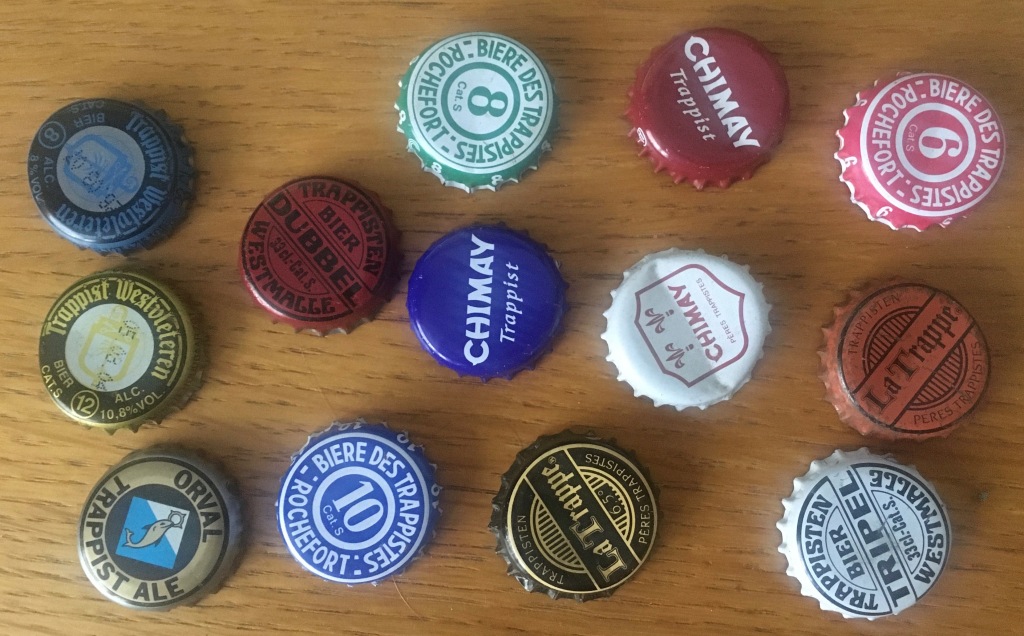For this post I’m taking the unusual step of repeating most of the previous one. Bear with me, it’ll make sense.
I’ve been bulk-buying Orval – and reordering before my stock runs out – since the first lockdown. As a result I’ve ended up with, oh, more than one or two bottles of it, including bottles from 2022, 2021 and 2020. Which I taste-tested back in September; the notes are repeated below. (The strong sharpness of the two-year-old makes me think now that there may have been something wrong with it – which is a shame, but you can only review the beer you’ve got.)
The reason I’m repeating this post is that I’ve recently completed the set with a couple of bottles of Orval that are – not two, not three, not five but – ten years old. (I bought them from Beeronweb.com, which as far as I know is still – nearly three years out from Brexit Day – the only generalist Belgian online beer retailer shipping to the UK; happy to be corrected if anyone knows otherwise.)
I drank one of the ten-year-olds last night. How did it compare? For background, here’s what I said about the first three, edited slightly for length.
Bottle 1: 9/6/2022; just under three months old
Reminds me oddly of an old-school English bitter, but deconstructed. The flavour seems to have the same overall ‘shape’, beginning with a bit of citric freshness in the front of the mouth, developing into something denser and heavier in the bitter/sweet region and finishing with tannic bitterness in mid-mouth, but without any bittering-hop aftertaste. There’s no big hit of malt, though, just a bitterness that gradually develops, accompanied oddly by a vague milk-chocolate sweetness.
But the big flavour element – the one that really drives through and carries the other flavour elements, in the way that bittering hops drive through a pale bitter – is the Brett. Call it old books, call it dry leaves, call it last night’s tobacco smoke; whatever you call it, there’s a lot of it in this beer. It’s there in the aroma, it’s there almost immediately after the start, and from there on it builds to the finish. The other elements – initial sharpness, hint of milk chocolate, dense bitterness – make this quite a complex flavour, but there’s never any doubt which element is in charge; balanced, this is not.
Bottle 2: 2/8/2021; a year and a month old.
Again, the flavour has that old-school English bitter profile, but in a much smoother, more integrated form. Grapefruit bitterness and a bit of citric fruit in the foretaste, but not in overpowering amounts; then there’s something sweetish – maybe even malty – with a bit of weight and body; then the whole thing is rounded off with mid-mouth bitterness, charcoal and dark chocolate. Again, it’s not a hoppy flavour – no flowery aromas and no back-of-the-throat bitterness.
As for the Brett, it’s there, but it’s behaving itself; it binds to the main flavour elements and hangs over them like a wisp of smoke (or sweat), only really making its presence felt in the aftertaste. At this age it only tastes of Brett in the same sense that chips taste of salt – which is to say, it doesn’t, except that you’d miss it if it wasn’t there.
Bottle 3: 6/6/2020; two years and three months old
This time the citric opening hit is in charge, slightly to my surprise, with a sharp note dominating almost all the way through. If the fresh version was “an old-school English bitter, but deconstructed”, two years later the flavour profile’s well and truly put itself together again; there’s very few fireworks or surprises between the sharp opening and the mid-mouth bitter finish. The wispy, smoky, old-books-y Brett element is definitely there, but it’s back in its box, mainly serving to make the mid-mouth flavour a bit more complex and bulk up the finish.
And now…
Bottle 4: 9/6/2012; almost ten and a half years old
I opened this bottle cautiously, mindful that – even at two years old – Orval tends to throw a tall, dense head, and sometimes even to gush. In this case I needn’t have worried: this is how it poured.
Whatever had been going on for those ten years, it hadn’t involved the continued accumulation of CO2. It wasn’t flat – if it was a cask beer you’d call it reasonably lively – but it certainly didn’t froth up at me.
But what did it taste like? The sharp note that had tended to dominate the two-year-old bottle was dialled right down; so too was the bitterness of the younger versions (and even they aren’t very bitter). I’m quite pleased to notice that I spotted a ‘milk chocolate’ note in the youngest version, because that was there in a big way: the dominant flavour, running right through this beer, is a combination of old-books funk with something big, smooth and – yes – slightly sweet. It’s a dense, complex flavour that rewards sipping, but if I had to sum it up those would definitely be the two elements I’d go for. There’s also a slightly dangerous-tasting overtone which I’d sum up as the taste of spontaneous fermentation – I mean, I’ve tasted things that had fermented although they weren’t intended to, and that’s what it reminded me of. My head this morning confirmed this impression, making me wonder if ten years in the bottle was enough to make a significant difference to the published a.b.v. of 6.2%.
Fascinating beer; the way the flavour gets more dense and integrated with the passage of time suggests it’s brewed with keeping in mind (the label does suggest a ‘best before’ age of five years, but I suspect that’s just for compliance with regulations). i’ve got one more bottle of the ten-year-old; perhaps I’ll hang on to it till next June and see if an eleventh year makes any difference.









